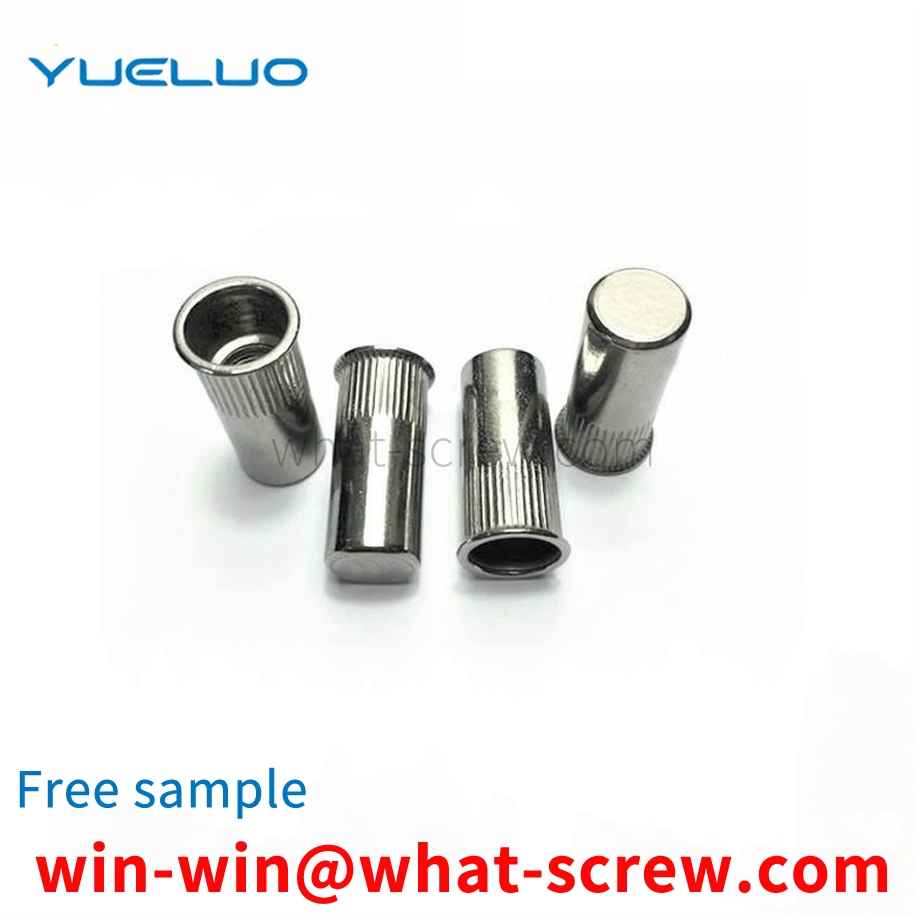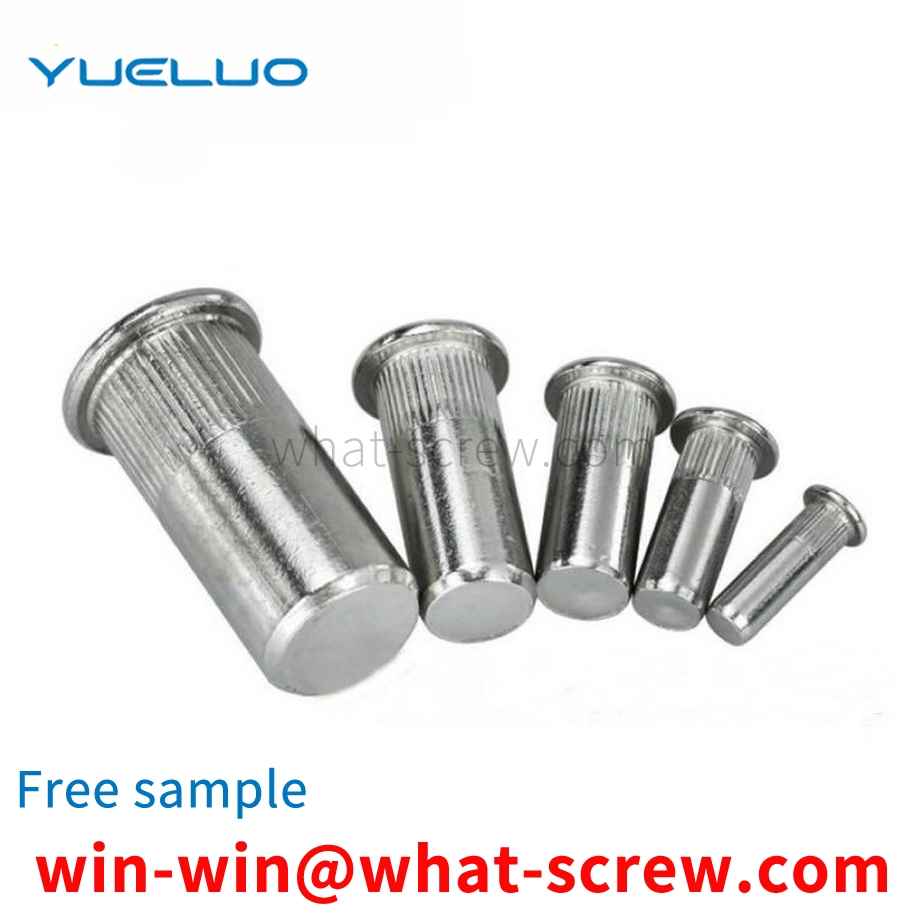The bolt thread is generally cold worked, so that the thread blank within a certain diameter range passes through the rubbing (rolling) wire plate (die), and the thread is formed by the pressure of the wire plate (rolling die). The plastic streamline of the threaded part is not cut off, the strength is increased, the precision is high, and the quality is uniform, so it is widely used. In order to make the outer diameter of the thread of the final product, the required thread blank diameter is different, because it is limited by factors such as thread accuracy and whether the material is coated or not. Rolling (rubbing) thread is a processing method that uses plastic deformation to form thread teeth. It uses a rolling (screwing plate) die with the same pitch and tooth shape as the thread to be processed, while extruding the cylindrical screw blank, while rotating the screw blank, and finally transferring the tooth shape on the rolling die to the On the screw blank, the thread is formed. The common point of rolling (rubbing) thread processing is that the number of rolling revolutions does not need to be too much. If it is too much, the efficiency will be low, and the surface of the thread teeth will easily cause separation or random buckle. On the contrary, if the number of revolutions is too small, the diameter of the thread is easy to be out of round, and the pressure at the initial stage of rolling increases abnormally, resulting in a shortening of the life of the die. Common defects of rolled threads: cracks or scratches on the surface of the thread part; random buckles; out of roundness of the thread part. If these defects occur in large numbers, they will be discovered during the processing stage. If the number of occurrences is small, the production process does not notice these defects and then circulates to users, causing trouble. Therefore, the key issues of processing conditions should be summarized, and these key factors should be controlled in the production process.
In view of the above-mentioned deficiencies of the prior art, Guangdong Yueluo Hardware Industry Co., Ltd. aims to provide a stamping die and stamping parts for punching rivets, and a positioning floating pin is added on the die to solve the problem of the prior art. The placement of the rivets during punching is inaccurate, resulting in the problem of poor quality. In order to achieve the above purpose, Guangdong Yueluo Hardware Industry Co., Ltd. has adopted the following technical solutions: a stamping die for punching rivets, including a lower die base, a lower die plate and a lower die insert block; the lower die plate and the lower die insert The block is arranged on the lower die base, and the lower die entry block passes through the lower die plate and protrudes to one side of the lower die plate, and a positioning floating pin is arranged in the lower die entry block, An elastic member for supporting the positioning lift pin is arranged in the lower die holder. The punching die for punching rivets further includes an upper die base, an upper clamping plate and a riveting punch, the upper clamping plate and the riveting punch are arranged on the upper die base, and the riveting punch passes through the upper die base. The upper splint extends to one side of the upper splint. In the punching die for punching rivets, the positioning and lifting pins are provided with protrusions for guiding the rivets. In the punching die for punching rivets, the lower die base is provided with a set screw for fixing the elastic member. In the punching die for punching rivets, the stop screw is installed on the bottom surface of the lower die base. In the punching die for punching rivets, a lower backing plate is arranged between the lower die base and the lower template. In the punching die for punching rivets, the elastic member is a spring. A stamping part is provided with rivets, and the rivets are stamped and fixed by the above-mentioned stamping die. In the stamping part, the stamping part is a back plate. Compared with prior art, the stamping die and the stamping part that Guangdong Yueluo Hardware Industry Co., Ltd. provides for punching rivets, have adopted and set up positioning floating pins in the lower die block, in the lower die holder An elastic piece for supporting the positioning lift pin is provided. Before punching, the positioning lift pin is held up by the elastic piece, so that the positioning lift pin extends out of the lower die into the block, and the rivet is placed on the positioning lift pin during stamping. On the pin, the rivet is guided by the positioning lift pin. During the stamping process, the rivet falls closely with the positioning lift pin to prevent the rivet from being skewed. When the stamping die is completely closed, the stamping is completed, which improves the quality of the stamped product and greatly improves the production efficiency.
The combination screw is actually a kind of screw, but it is special. It is generally a three-component or a two-component, but at least it can be called a combination screw. The main difference from ordinary screws is that they are equipped with one more spring washer or one more flat washer than ordinary screws. This is the main difference between the appearance of combination screws and ordinary screws. In addition to the obvious difference in appearance between combination screws and ordinary screws, the main difference is the difference in mechanical properties and uses. The combination screw is a three-component or two-component with a flat washer. Of course, it is equipped with a flat washer by an ordinary screw. When the spring flat pad is attached, the spring flat pad will not fall off. Fastened to form an assembly. In terms of mechanical performance, the combination screw is composed of three accessories, and in terms of performance, three fasteners must be used together. The mechanical properties of the combined screw are stronger when used. More convenient, the biggest advantage of the combined screw is that the production line can be operated conveniently and quickly, and the work efficiency can be improved. The difference between the use of combination screws and ordinary screws is mainly in the breadth of use. The use of ordinary screws is more extensive than that of combination screws. Basically, ordinary screws are used in industrial products, and combination screws! It is only useful for specific product materials. When the screw needs to be used with a spring washer and a flat washer, the combination screw can be used at this time.
In some special occasions, both objects need to be riveted and have good waterproof performance. The existing rivets have poor waterproof performance and often have problems such as water seepage.
The inch thread is the thread size marked in inch. According to the shape, it is divided into two types: cylindrical and conical; according to the tooth angle, it is divided into two types: 55° and 60°. The 1/4, 1/2, 1/8 marks in the thread refer to the diameter of the thread size in inches. One inch equals 8 cents, 1/4 inch equals 2 cents, and so on.
We have many years of experience in the production and sales of screws, nuts, flat washers, etc. The main products are: 201 stainless steel lock nuts, hexagonal inch nuts, high-strength carbon steel, internal multi-tooth washers and other products, we can provide you with suitable tightening nuts. Firmware Solutions.



















 Service Hotline
Service Hotline




